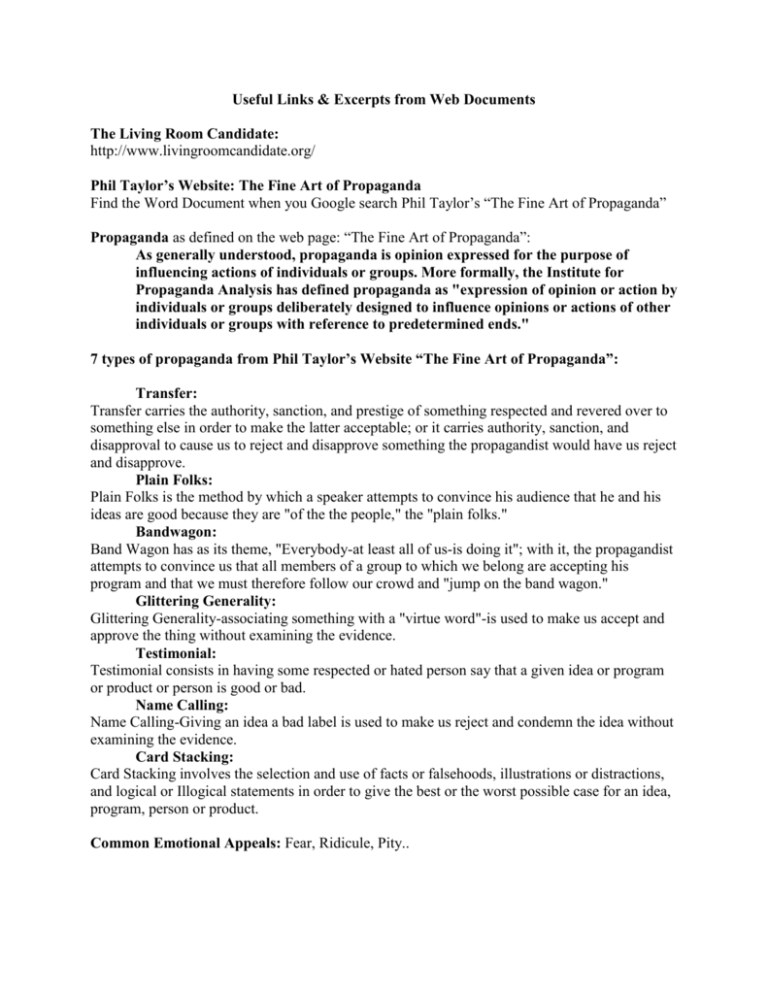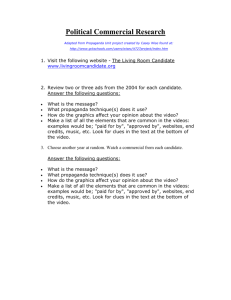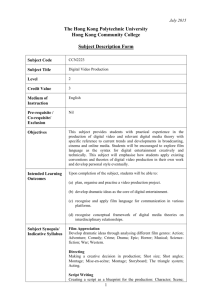7 types of propaganda:
advertisement

Useful Links & Excerpts from Web Documents The Living Room Candidate: http://www.livingroomcandidate.org/ Phil Taylor’s Website: The Fine Art of Propaganda Find the Word Document when you Google search Phil Taylor’s “The Fine Art of Propaganda” Propaganda as defined on the web page: “The Fine Art of Propaganda”: As generally understood, propaganda is opinion expressed for the purpose of influencing actions of individuals or groups. More formally, the Institute for Propaganda Analysis has defined propaganda as "expression of opinion or action by individuals or groups deliberately designed to influence opinions or actions of other individuals or groups with reference to predetermined ends." 7 types of propaganda from Phil Taylor’s Website “The Fine Art of Propaganda”: Transfer: Transfer carries the authority, sanction, and prestige of something respected and revered over to something else in order to make the latter acceptable; or it carries authority, sanction, and disapproval to cause us to reject and disapprove something the propagandist would have us reject and disapprove. Plain Folks: Plain Folks is the method by which a speaker attempts to convince his audience that he and his ideas are good because they are "of the the people," the "plain folks." Bandwagon: Band Wagon has as its theme, "Everybody-at least all of us-is doing it"; with it, the propagandist attempts to convince us that all members of a group to which we belong are accepting his program and that we must therefore follow our crowd and "jump on the band wagon." Glittering Generality: Glittering Generality-associating something with a "virtue word"-is used to make us accept and approve the thing without examining the evidence. Testimonial: Testimonial consists in having some respected or hated person say that a given idea or program or product or person is good or bad. Name Calling: Name Calling-Giving an idea a bad label is used to make us reject and condemn the idea without examining the evidence. Card Stacking: Card Stacking involves the selection and use of facts or falsehoods, illustrations or distractions, and logical or Illogical statements in order to give the best or the worst possible case for an idea, program, person or product. Common Emotional Appeals: Fear, Ridicule, Pity.. Emotional Appeals (The following is excerpted from writing@csu a Colorado State University Website) http://writing.colostate.edu/guides/documents/argueparts/emotionalappeals.cfm Emotional appeals are generally frowned upon in academic circles for the simple reason that they tend to get in the way of logic and reason, the prerequisites of an academic argument. However, under the right circumstances, they can be quite effective. Drawing on our most basic instincts and feelings an emotional appeal can illustrate a truth or depict the reality of a fact in an emotive way far more compelling than a logical or ethical appeal. For example: Studies show that women earn 80 cents to every dollar earned by a man. What these statistics don't illustrate well is the effect this lesser earning potential has on women's lives. Take Irma as an example. Irma works as a nurse in a major hospital, yet takes home only $250 a week. On this money, she must support her four children whose father abandoned them when the youngest was six months old. With rent at $700 a week, she has only $300 left over for food, clothing, and her own needs. As she describes it, "it's heartbreaking to have to tell my daughter that she has to wear hand-me-downs one more year to begin school or to tell my son that he can't join the baseball league because we can't afford the fee for the uniform. It's even worse when I watch them eat pasta day after day without complaint because our budget doesn't allow for much meat." It's even more frustrating, she explains, when she realizes not all nurses doing the same job are earning the same pay. "Last month, I heard one of the male nurses got a raise because he was supporting a family of four. What makes them think women aren't in the same situation?" Be cautious using emotional appeals. They have no place in an academic argument if their purpose-as often seen in advertising and politics-is to deceive or distort. When appropriate, use them to introduce an argument that proceeds logically and is supported with acceptable forms of evidence (e.g., statistics, research studies) or, to follow, as a graphic or human illustration of what the evidence suggests. Cinematic Terms Definition and Explanation Example (if applicable) allusion a direct or indirect reference - through an image or through dialogue - to the Bible, a classic, a person, a place, an external and/or real-life event, another film, or a well-known cultural idea. Example: In Red River (1948), Montgomery Clift (as Matt Dunson) and John Ireland (as Cherry Valance) show off their guns to each other and ask: "You know, there are only two things more beautiful than a good gun: a Swiss watch or a woman from anywhere. You ever had a good Swiss watch?" - a scene often interpreted as alluding to homosexuality cross-cutting the editing technique of alternating, interweaving, or interspersing one narrative action (scene, sequence, or event) with another - usually in different locations or places, thus combining the two; this editing method suggests parallel action (that takes place simultaneously); often used to dramatically build tension and suspense in chase scenes, or to compare two different scenes; also known as inter-cutting or parallel editing. cut (or cutting) an abrupt or sudden change or jump in camera angle, location, placement, or time, from one shot to another; consists of a transition from one scene to another (a visual cut) or from one soundtrack to another (a sound cut); cutting refers to the selection, splicing and assembly by the film editor of the various shots or sequences for a reel of film, and the process of shortening a scene; also refers to the instructional word 'cut' said at the end of a take by the director to stop the action in front of the camera; cut to refers to the point at which one shot or scene is changed immediately to another; also refers to a complete edited version of a film (e.g., rough cut); also see director's cut; various types of cuts include invisible cut, smooth cut, jump cut, shock cut, etc. shot the basic building block or unit of film narrative; refers to a single, constant take made by a motion picture camera uninterrupted by editing, interruptions or cuts, in which a length of film is exposed by turning the camera on, recording, and then turning the camera off; it can also refer to a single film frame (such as a still image); a followshot is when the camera moves to follow the action; a pull-back shot refers to a tracking shot or zoom that moves back from the subject to reveal the context of the scene; see also scene and sequence; shot analysis refers to the examination of individual shots; a one-shot, a two-shot, and a three-shot refers to common names for shooting just one, two, or three people in a shot shot, scene, and sequence a shot, scene, and sequence together make up the larger dramatic narrative of film; scenes are composed of shots, sequences are composed of scenes, and films are composed of sequences. still refers to a single, static image, either (1) a frame still (possibly enlarged) from a finished film, (2) a production still taken from an unfinished film, or (3) a publicity shot (of an actor or scene); aka photogram. montage a French word literally meaning "editing", "putting together" or "assembling shots"; refers to a filming technique, editing style, or form of movie collage consisting of a series of short shots or images that are rapidly put together into a coherent sequence to create a composite picture, or to suggest meaning or a larger idea; a montage is usually not accompanied with dialogue; dissolves, cuts, fades, super-impositions, and wipes are often used to link the images in a montage sequence; an accelerated montage is composed of shots of increasingly-shorter lengths; contrast to mise-en-scene. overlap the carry-over of dialogue, sounds, or music from one scene to another; occurs when the cut in the soundtrack is not at the same time as the cut in the image; aka overlap sound. voice-over (or v.o.) refers to recorded dialogue, usually narration, that comes from an unseen, off-screen voice, character or narrator (abbreviated as o.s. meaning beyond camera range), that can be heard by the audience but not by the film characters themselves; narration is a type of voice-over; v.o. often conveys the character's thoughts, either as a 'voice' heard within one's head, or as other narrative information and commentary; often a technique in film noirs; the abbreviation is used as an annotation in a script. Capt. Willard's voice-overs in Apocalypse Now (1979), Deckard's v.o. in Hollywood's version of Ridley Scott's Blade Runner (1982), the mortally wounded hero's flashback narration in Double Indemnity (1944), or the voice-over narrated by the dead man floating in a pool in the opening of Sunset Boulevard (1950) . Dirks, Tim. Excerpts from Cinematic Terms: A Film-Making Glossary. 1996-2008. April 2008. <http://www.filmsite.org/filmterms20.html> 29 Classwork or Homework to Turn in: Please do the following to prepare to write your paper and to show me you can identify emotional and propaganda techniques. Campaign Ads to Analyze and Describe 1 Read and take notes of Phil Taylor’s “The Fine Art of Propaganda” (especially of good quotes and info needed to identify these ads). It is posted at our class website as “Propaganda Essay” 2. Click on the links below and then find the ad with the title given and the picture as I showed you in class. Watch the ad, then on a piece of paper write down the name of the year, the candidate, the title of the ad, and identify any propaganda techniques or non-rational appeals used, explaining briefly how that appeal or technique is used in the ad. George Bush Ad: “Windsurfing” http://www.livingroomcandidate.org/commercials/2004 John McCain Ad: “Man in the Arena” http://www.livingroomcandidate.org/commercials/2008 George Bush (Senior): “Revolving Door” http://www.livingroomcandidate.org/commercials/1988 Bill Clinton “Milwaukee” http://www.livingroomcandidate.org/commercials/1992 Barack Obama “Country I Love” http://www.livingroomcandidate.org/commercials/2008



